Financial Management: Ratio Analysis and Decision-Making Process
VerifiedAdded on 2023/01/10
|21
|5508
|99
Report
AI Summary
This report provides an analysis of financial management, covering decision-making approaches, stakeholder management, and the value of management accounting techniques in controlling costs and maximizing shareholder value. It includes a financial ratio analysis of J Sainsbury PLC for the years 2018, 2019, and 2020, examining investment appraisal techniques and recommendations for improving financial sustainability. The report also discusses fraud detection and prevention techniques, ethical decision-making approaches, and the role of financial decision-making in long-term sustainability. The overall aim is to provide insights into effective financial resource management and strategic decision-making within a business context, aligning with the principles of financial management for optimal resource utilization.
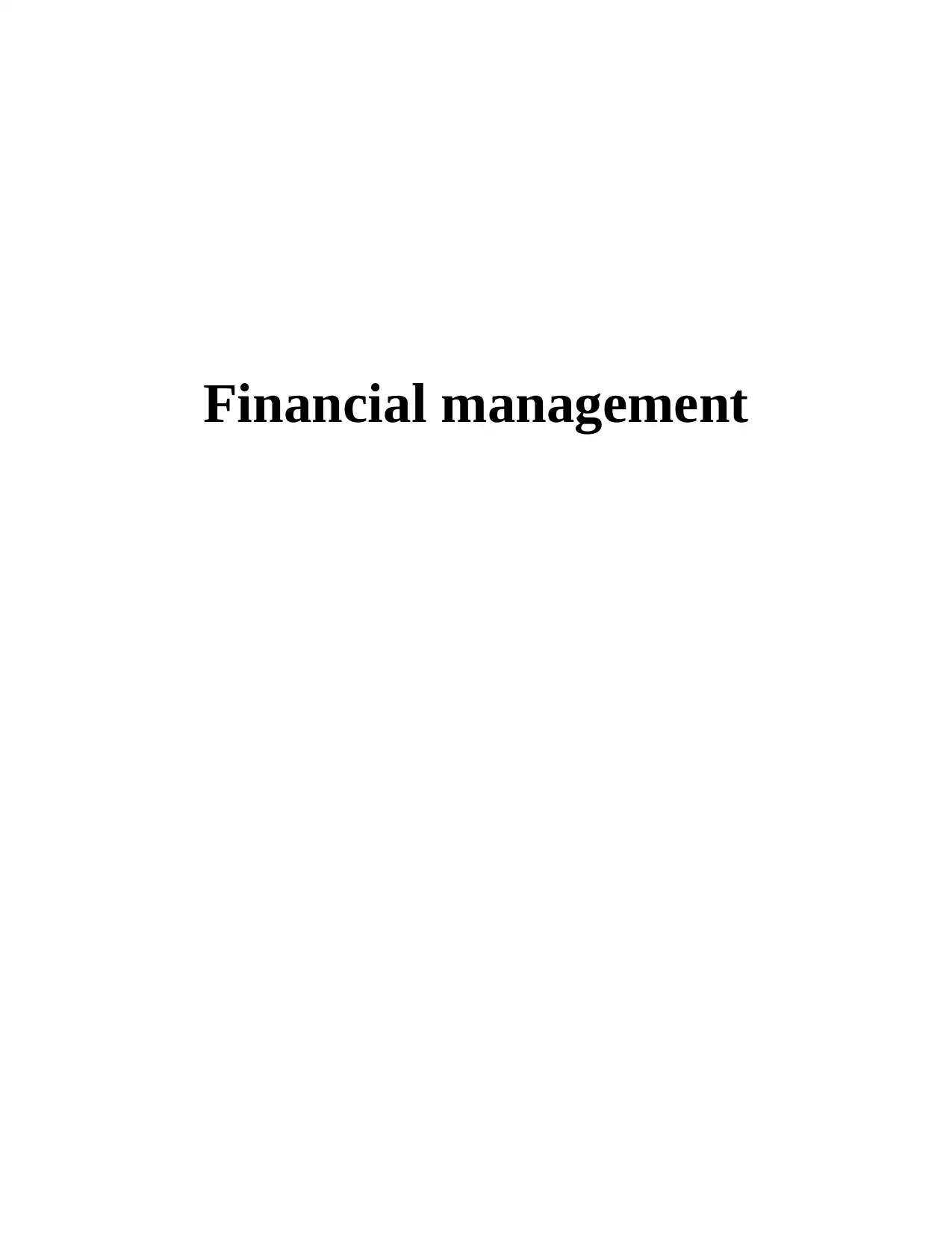
Financial management
Paraphrase This Document
Need a fresh take? Get an instant paraphrase of this document with our AI Paraphraser
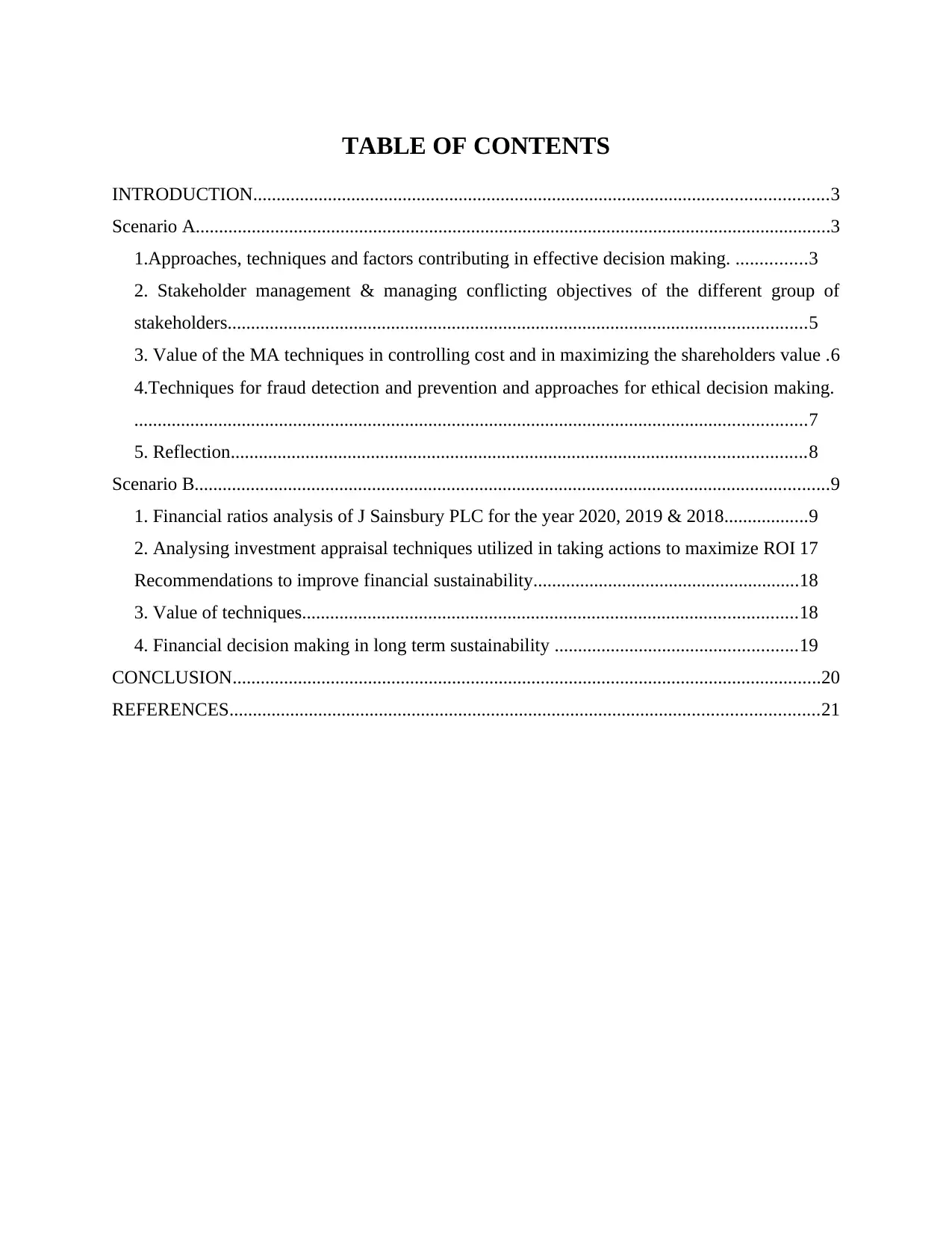
TABLE OF CONTENTS
INTRODUCTION...........................................................................................................................3
Scenario A........................................................................................................................................3
1.Approaches, techniques and factors contributing in effective decision making. ...............3
2. Stakeholder management & managing conflicting objectives of the different group of
stakeholders............................................................................................................................5
3. Value of the MA techniques in controlling cost and in maximizing the shareholders value .6
4.Techniques for fraud detection and prevention and approaches for ethical decision making.
................................................................................................................................................7
5. Reflection...........................................................................................................................8
Scenario B........................................................................................................................................9
1. Financial ratios analysis of J Sainsbury PLC for the year 2020, 2019 & 2018..................9
2. Analysing investment appraisal techniques utilized in taking actions to maximize ROI 17
Recommendations to improve financial sustainability.........................................................18
3. Value of techniques..........................................................................................................18
4. Financial decision making in long term sustainability ....................................................19
CONCLUSION..............................................................................................................................20
REFERENCES..............................................................................................................................21
INTRODUCTION...........................................................................................................................3
Scenario A........................................................................................................................................3
1.Approaches, techniques and factors contributing in effective decision making. ...............3
2. Stakeholder management & managing conflicting objectives of the different group of
stakeholders............................................................................................................................5
3. Value of the MA techniques in controlling cost and in maximizing the shareholders value .6
4.Techniques for fraud detection and prevention and approaches for ethical decision making.
................................................................................................................................................7
5. Reflection...........................................................................................................................8
Scenario B........................................................................................................................................9
1. Financial ratios analysis of J Sainsbury PLC for the year 2020, 2019 & 2018..................9
2. Analysing investment appraisal techniques utilized in taking actions to maximize ROI 17
Recommendations to improve financial sustainability.........................................................18
3. Value of techniques..........................................................................................................18
4. Financial decision making in long term sustainability ....................................................19
CONCLUSION..............................................................................................................................20
REFERENCES..............................................................................................................................21
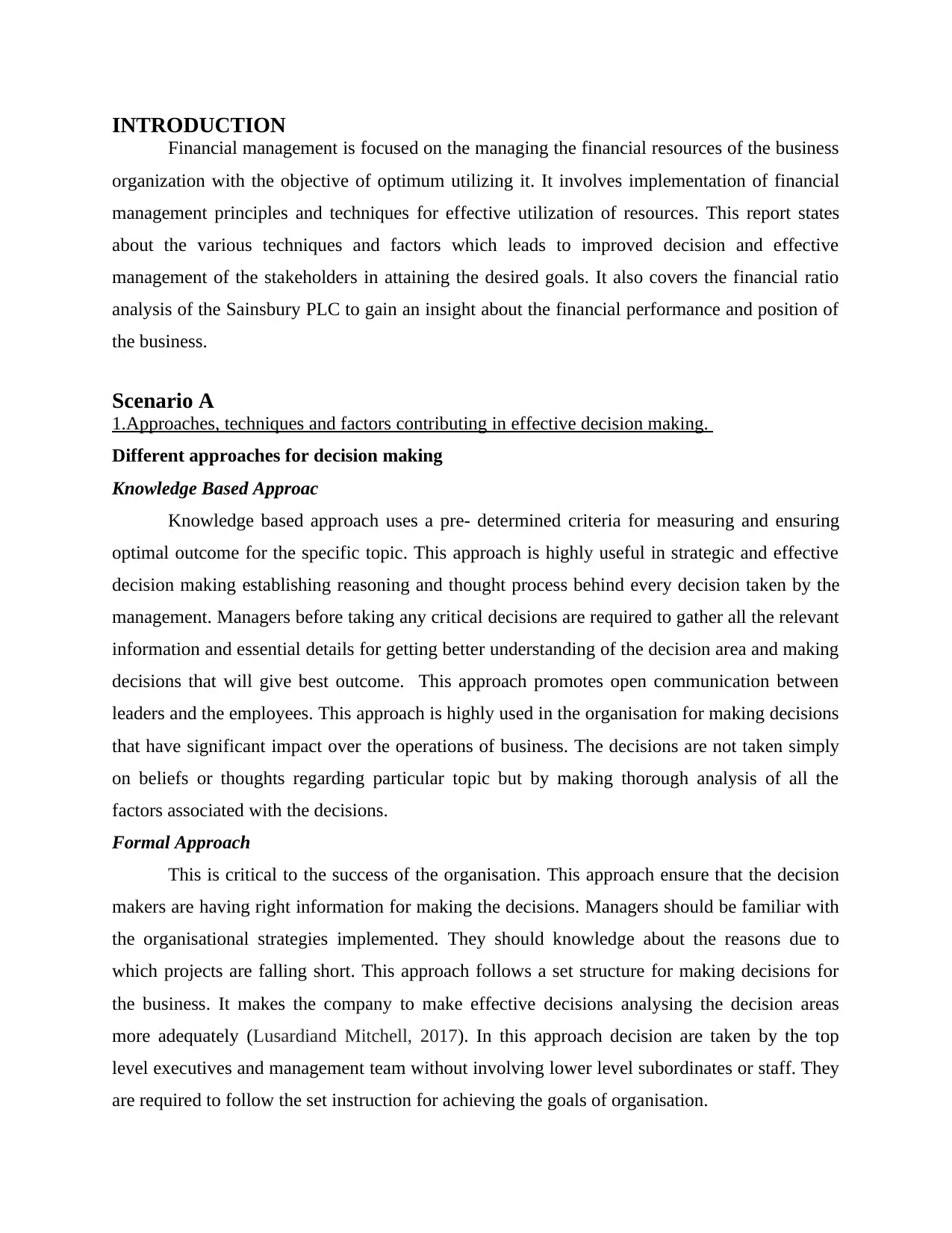
INTRODUCTION
Financial management is focused on the managing the financial resources of the business
organization with the objective of optimum utilizing it. It involves implementation of financial
management principles and techniques for effective utilization of resources. This report states
about the various techniques and factors which leads to improved decision and effective
management of the stakeholders in attaining the desired goals. It also covers the financial ratio
analysis of the Sainsbury PLC to gain an insight about the financial performance and position of
the business.
Scenario A
1.Approaches, techniques and factors contributing in effective decision making.
Different approaches for decision making
Knowledge Based Approac
Knowledge based approach uses a pre- determined criteria for measuring and ensuring
optimal outcome for the specific topic. This approach is highly useful in strategic and effective
decision making establishing reasoning and thought process behind every decision taken by the
management. Managers before taking any critical decisions are required to gather all the relevant
information and essential details for getting better understanding of the decision area and making
decisions that will give best outcome. This approach promotes open communication between
leaders and the employees. This approach is highly used in the organisation for making decisions
that have significant impact over the operations of business. The decisions are not taken simply
on beliefs or thoughts regarding particular topic but by making thorough analysis of all the
factors associated with the decisions.
Formal Approach
This is critical to the success of the organisation. This approach ensure that the decision
makers are having right information for making the decisions. Managers should be familiar with
the organisational strategies implemented. They should knowledge about the reasons due to
which projects are falling short. This approach follows a set structure for making decisions for
the business. It makes the company to make effective decisions analysing the decision areas
more adequately (Lusardiand Mitchell, 2017). In this approach decision are taken by the top
level executives and management team without involving lower level subordinates or staff. They
are required to follow the set instruction for achieving the goals of organisation.
Financial management is focused on the managing the financial resources of the business
organization with the objective of optimum utilizing it. It involves implementation of financial
management principles and techniques for effective utilization of resources. This report states
about the various techniques and factors which leads to improved decision and effective
management of the stakeholders in attaining the desired goals. It also covers the financial ratio
analysis of the Sainsbury PLC to gain an insight about the financial performance and position of
the business.
Scenario A
1.Approaches, techniques and factors contributing in effective decision making.
Different approaches for decision making
Knowledge Based Approac
Knowledge based approach uses a pre- determined criteria for measuring and ensuring
optimal outcome for the specific topic. This approach is highly useful in strategic and effective
decision making establishing reasoning and thought process behind every decision taken by the
management. Managers before taking any critical decisions are required to gather all the relevant
information and essential details for getting better understanding of the decision area and making
decisions that will give best outcome. This approach promotes open communication between
leaders and the employees. This approach is highly used in the organisation for making decisions
that have significant impact over the operations of business. The decisions are not taken simply
on beliefs or thoughts regarding particular topic but by making thorough analysis of all the
factors associated with the decisions.
Formal Approach
This is critical to the success of the organisation. This approach ensure that the decision
makers are having right information for making the decisions. Managers should be familiar with
the organisational strategies implemented. They should knowledge about the reasons due to
which projects are falling short. This approach follows a set structure for making decisions for
the business. It makes the company to make effective decisions analysing the decision areas
more adequately (Lusardiand Mitchell, 2017). In this approach decision are taken by the top
level executives and management team without involving lower level subordinates or staff. They
are required to follow the set instruction for achieving the goals of organisation.
⊘ This is a preview!⊘
Do you want full access?
Subscribe today to unlock all pages.

Trusted by 1+ million students worldwide
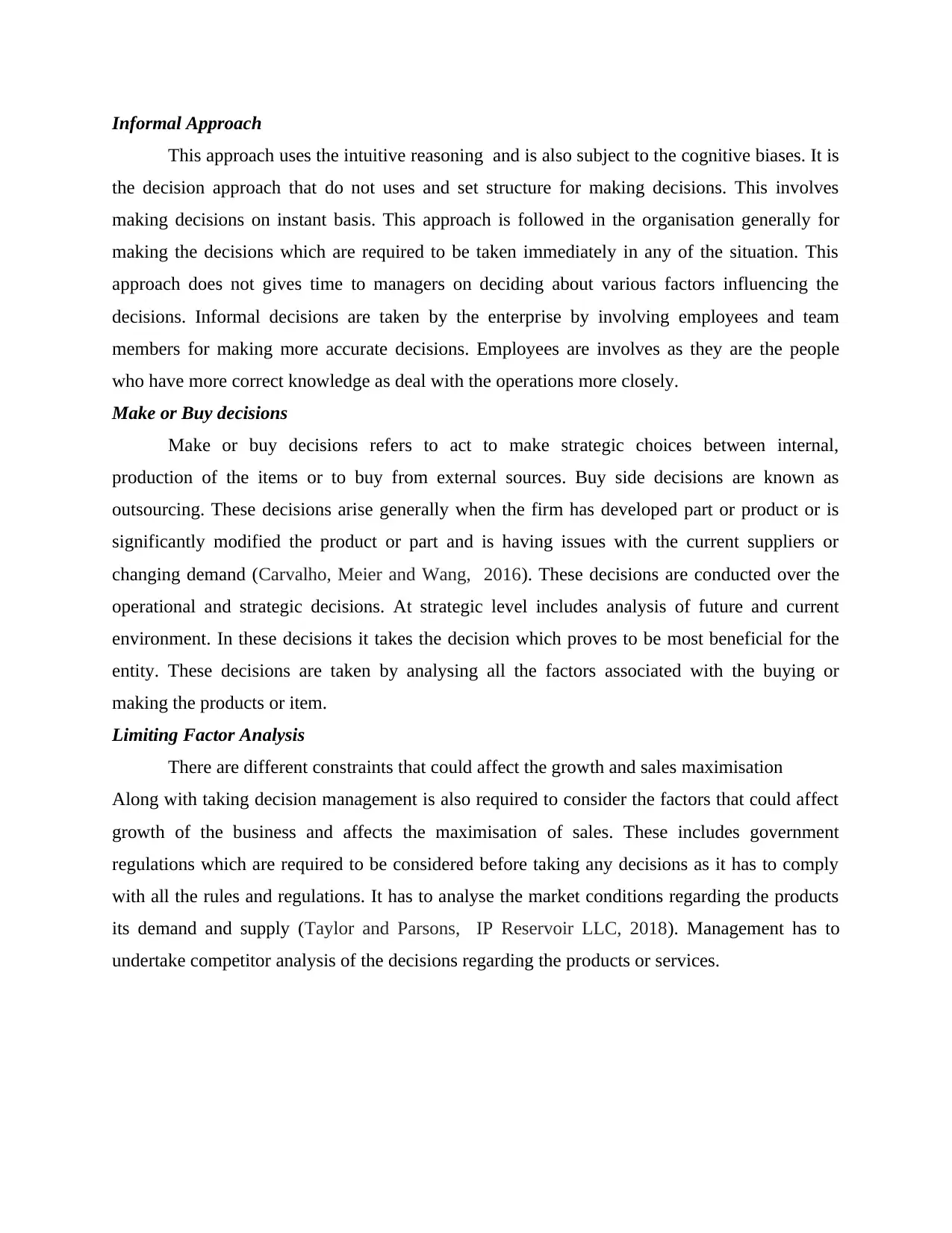
Informal Approach
This approach uses the intuitive reasoning and is also subject to the cognitive biases. It is
the decision approach that do not uses and set structure for making decisions. This involves
making decisions on instant basis. This approach is followed in the organisation generally for
making the decisions which are required to be taken immediately in any of the situation. This
approach does not gives time to managers on deciding about various factors influencing the
decisions. Informal decisions are taken by the enterprise by involving employees and team
members for making more accurate decisions. Employees are involves as they are the people
who have more correct knowledge as deal with the operations more closely.
Make or Buy decisions
Make or buy decisions refers to act to make strategic choices between internal,
production of the items or to buy from external sources. Buy side decisions are known as
outsourcing. These decisions arise generally when the firm has developed part or product or is
significantly modified the product or part and is having issues with the current suppliers or
changing demand (Carvalho, Meier and Wang, 2016). These decisions are conducted over the
operational and strategic decisions. At strategic level includes analysis of future and current
environment. In these decisions it takes the decision which proves to be most beneficial for the
entity. These decisions are taken by analysing all the factors associated with the buying or
making the products or item.
Limiting Factor Analysis
There are different constraints that could affect the growth and sales maximisation
Along with taking decision management is also required to consider the factors that could affect
growth of the business and affects the maximisation of sales. These includes government
regulations which are required to be considered before taking any decisions as it has to comply
with all the rules and regulations. It has to analyse the market conditions regarding the products
its demand and supply (Taylor and Parsons, IP Reservoir LLC, 2018). Management has to
undertake competitor analysis of the decisions regarding the products or services.
This approach uses the intuitive reasoning and is also subject to the cognitive biases. It is
the decision approach that do not uses and set structure for making decisions. This involves
making decisions on instant basis. This approach is followed in the organisation generally for
making the decisions which are required to be taken immediately in any of the situation. This
approach does not gives time to managers on deciding about various factors influencing the
decisions. Informal decisions are taken by the enterprise by involving employees and team
members for making more accurate decisions. Employees are involves as they are the people
who have more correct knowledge as deal with the operations more closely.
Make or Buy decisions
Make or buy decisions refers to act to make strategic choices between internal,
production of the items or to buy from external sources. Buy side decisions are known as
outsourcing. These decisions arise generally when the firm has developed part or product or is
significantly modified the product or part and is having issues with the current suppliers or
changing demand (Carvalho, Meier and Wang, 2016). These decisions are conducted over the
operational and strategic decisions. At strategic level includes analysis of future and current
environment. In these decisions it takes the decision which proves to be most beneficial for the
entity. These decisions are taken by analysing all the factors associated with the buying or
making the products or item.
Limiting Factor Analysis
There are different constraints that could affect the growth and sales maximisation
Along with taking decision management is also required to consider the factors that could affect
growth of the business and affects the maximisation of sales. These includes government
regulations which are required to be considered before taking any decisions as it has to comply
with all the rules and regulations. It has to analyse the market conditions regarding the products
its demand and supply (Taylor and Parsons, IP Reservoir LLC, 2018). Management has to
undertake competitor analysis of the decisions regarding the products or services.
Paraphrase This Document
Need a fresh take? Get an instant paraphrase of this document with our AI Paraphraser
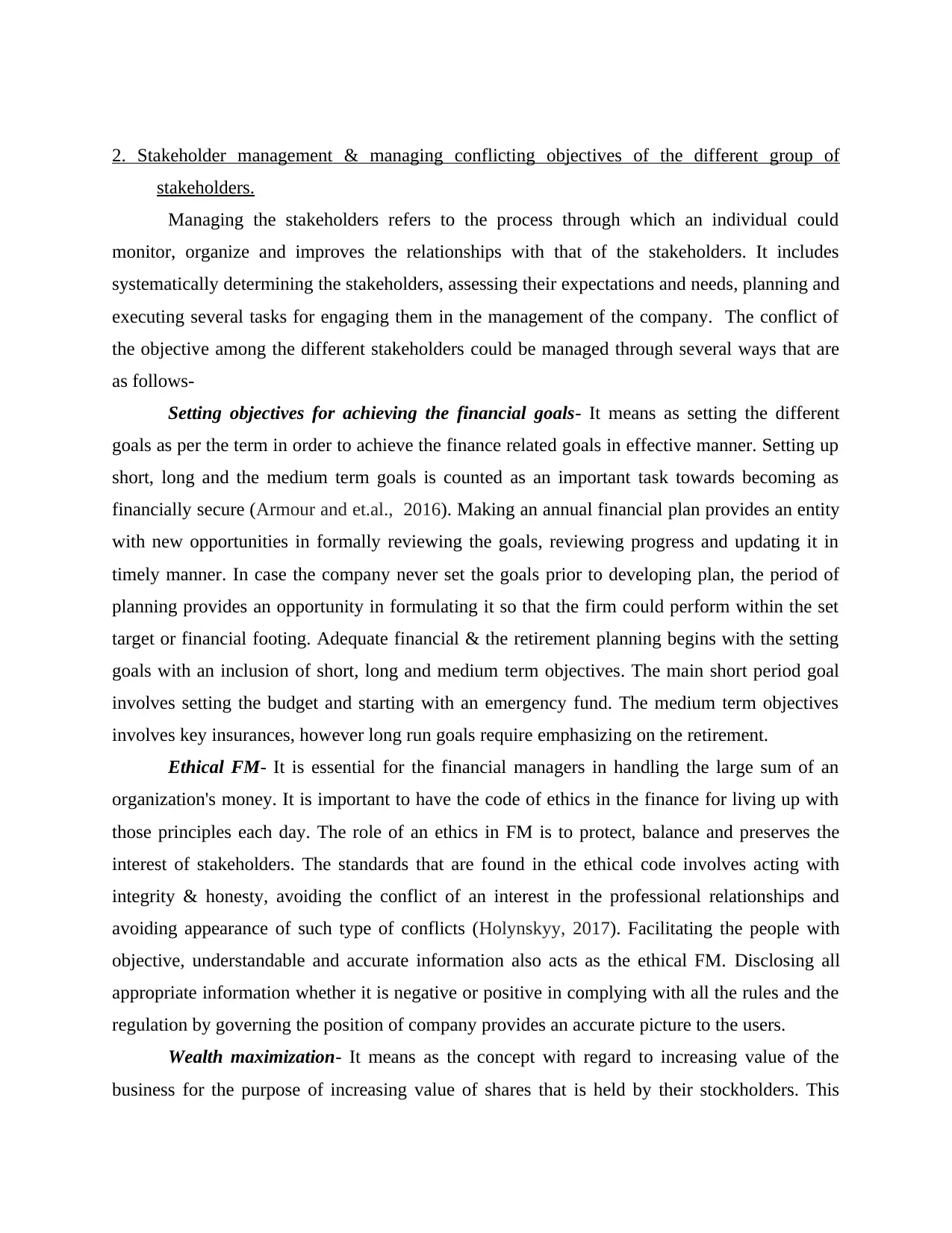
2. Stakeholder management & managing conflicting objectives of the different group of
stakeholders.
Managing the stakeholders refers to the process through which an individual could
monitor, organize and improves the relationships with that of the stakeholders. It includes
systematically determining the stakeholders, assessing their expectations and needs, planning and
executing several tasks for engaging them in the management of the company. The conflict of
the objective among the different stakeholders could be managed through several ways that are
as follows-
Setting objectives for achieving the financial goals- It means as setting the different
goals as per the term in order to achieve the finance related goals in effective manner. Setting up
short, long and the medium term goals is counted as an important task towards becoming as
financially secure (Armour and et.al., 2016). Making an annual financial plan provides an entity
with new opportunities in formally reviewing the goals, reviewing progress and updating it in
timely manner. In case the company never set the goals prior to developing plan, the period of
planning provides an opportunity in formulating it so that the firm could perform within the set
target or financial footing. Adequate financial & the retirement planning begins with the setting
goals with an inclusion of short, long and medium term objectives. The main short period goal
involves setting the budget and starting with an emergency fund. The medium term objectives
involves key insurances, however long run goals require emphasizing on the retirement.
Ethical FM- It is essential for the financial managers in handling the large sum of an
organization's money. It is important to have the code of ethics in the finance for living up with
those principles each day. The role of an ethics in FM is to protect, balance and preserves the
interest of stakeholders. The standards that are found in the ethical code involves acting with
integrity & honesty, avoiding the conflict of an interest in the professional relationships and
avoiding appearance of such type of conflicts (Holynskyy, 2017). Facilitating the people with
objective, understandable and accurate information also acts as the ethical FM. Disclosing all
appropriate information whether it is negative or positive in complying with all the rules and the
regulation by governing the position of company provides an accurate picture to the users.
Wealth maximization- It means as the concept with regard to increasing value of the
business for the purpose of increasing value of shares that is held by their stockholders. This
stakeholders.
Managing the stakeholders refers to the process through which an individual could
monitor, organize and improves the relationships with that of the stakeholders. It includes
systematically determining the stakeholders, assessing their expectations and needs, planning and
executing several tasks for engaging them in the management of the company. The conflict of
the objective among the different stakeholders could be managed through several ways that are
as follows-
Setting objectives for achieving the financial goals- It means as setting the different
goals as per the term in order to achieve the finance related goals in effective manner. Setting up
short, long and the medium term goals is counted as an important task towards becoming as
financially secure (Armour and et.al., 2016). Making an annual financial plan provides an entity
with new opportunities in formally reviewing the goals, reviewing progress and updating it in
timely manner. In case the company never set the goals prior to developing plan, the period of
planning provides an opportunity in formulating it so that the firm could perform within the set
target or financial footing. Adequate financial & the retirement planning begins with the setting
goals with an inclusion of short, long and medium term objectives. The main short period goal
involves setting the budget and starting with an emergency fund. The medium term objectives
involves key insurances, however long run goals require emphasizing on the retirement.
Ethical FM- It is essential for the financial managers in handling the large sum of an
organization's money. It is important to have the code of ethics in the finance for living up with
those principles each day. The role of an ethics in FM is to protect, balance and preserves the
interest of stakeholders. The standards that are found in the ethical code involves acting with
integrity & honesty, avoiding the conflict of an interest in the professional relationships and
avoiding appearance of such type of conflicts (Holynskyy, 2017). Facilitating the people with
objective, understandable and accurate information also acts as the ethical FM. Disclosing all
appropriate information whether it is negative or positive in complying with all the rules and the
regulation by governing the position of company provides an accurate picture to the users.
Wealth maximization- It means as the concept with regard to increasing value of the
business for the purpose of increasing value of shares that is held by their stockholders. This
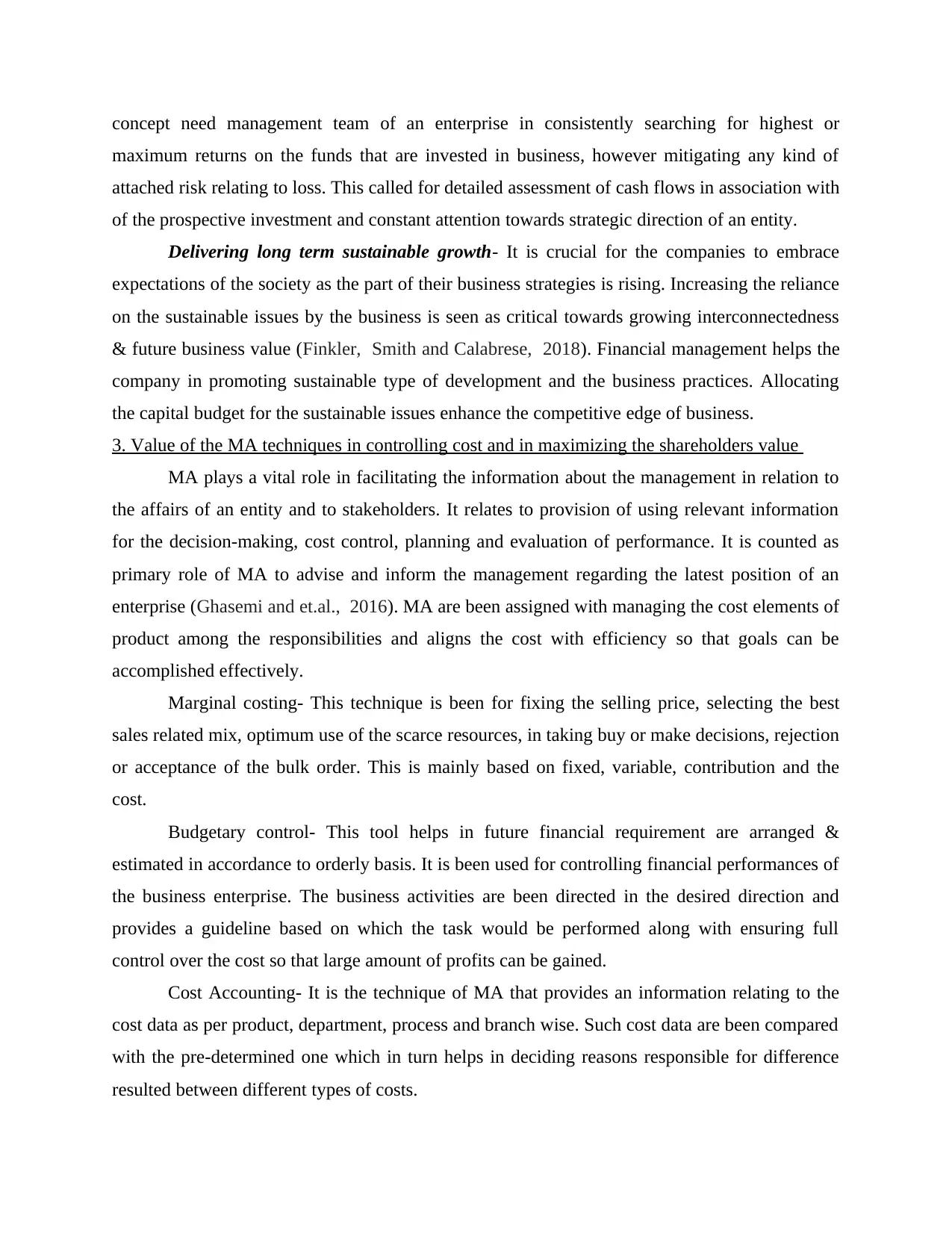
concept need management team of an enterprise in consistently searching for highest or
maximum returns on the funds that are invested in business, however mitigating any kind of
attached risk relating to loss. This called for detailed assessment of cash flows in association with
of the prospective investment and constant attention towards strategic direction of an entity.
Delivering long term sustainable growth- It is crucial for the companies to embrace
expectations of the society as the part of their business strategies is rising. Increasing the reliance
on the sustainable issues by the business is seen as critical towards growing interconnectedness
& future business value (Finkler, Smith and Calabrese, 2018). Financial management helps the
company in promoting sustainable type of development and the business practices. Allocating
the capital budget for the sustainable issues enhance the competitive edge of business.
3. Value of the MA techniques in controlling cost and in maximizing the shareholders value
MA plays a vital role in facilitating the information about the management in relation to
the affairs of an entity and to stakeholders. It relates to provision of using relevant information
for the decision-making, cost control, planning and evaluation of performance. It is counted as
primary role of MA to advise and inform the management regarding the latest position of an
enterprise (Ghasemi and et.al., 2016). MA are been assigned with managing the cost elements of
product among the responsibilities and aligns the cost with efficiency so that goals can be
accomplished effectively.
Marginal costing- This technique is been for fixing the selling price, selecting the best
sales related mix, optimum use of the scarce resources, in taking buy or make decisions, rejection
or acceptance of the bulk order. This is mainly based on fixed, variable, contribution and the
cost.
Budgetary control- This tool helps in future financial requirement are arranged &
estimated in accordance to orderly basis. It is been used for controlling financial performances of
the business enterprise. The business activities are been directed in the desired direction and
provides a guideline based on which the task would be performed along with ensuring full
control over the cost so that large amount of profits can be gained.
Cost Accounting- It is the technique of MA that provides an information relating to the
cost data as per product, department, process and branch wise. Such cost data are been compared
with the pre-determined one which in turn helps in deciding reasons responsible for difference
resulted between different types of costs.
maximum returns on the funds that are invested in business, however mitigating any kind of
attached risk relating to loss. This called for detailed assessment of cash flows in association with
of the prospective investment and constant attention towards strategic direction of an entity.
Delivering long term sustainable growth- It is crucial for the companies to embrace
expectations of the society as the part of their business strategies is rising. Increasing the reliance
on the sustainable issues by the business is seen as critical towards growing interconnectedness
& future business value (Finkler, Smith and Calabrese, 2018). Financial management helps the
company in promoting sustainable type of development and the business practices. Allocating
the capital budget for the sustainable issues enhance the competitive edge of business.
3. Value of the MA techniques in controlling cost and in maximizing the shareholders value
MA plays a vital role in facilitating the information about the management in relation to
the affairs of an entity and to stakeholders. It relates to provision of using relevant information
for the decision-making, cost control, planning and evaluation of performance. It is counted as
primary role of MA to advise and inform the management regarding the latest position of an
enterprise (Ghasemi and et.al., 2016). MA are been assigned with managing the cost elements of
product among the responsibilities and aligns the cost with efficiency so that goals can be
accomplished effectively.
Marginal costing- This technique is been for fixing the selling price, selecting the best
sales related mix, optimum use of the scarce resources, in taking buy or make decisions, rejection
or acceptance of the bulk order. This is mainly based on fixed, variable, contribution and the
cost.
Budgetary control- This tool helps in future financial requirement are arranged &
estimated in accordance to orderly basis. It is been used for controlling financial performances of
the business enterprise. The business activities are been directed in the desired direction and
provides a guideline based on which the task would be performed along with ensuring full
control over the cost so that large amount of profits can be gained.
Cost Accounting- It is the technique of MA that provides an information relating to the
cost data as per product, department, process and branch wise. Such cost data are been compared
with the pre-determined one which in turn helps in deciding reasons responsible for difference
resulted between different types of costs.
⊘ This is a preview!⊘
Do you want full access?
Subscribe today to unlock all pages.

Trusted by 1+ million students worldwide
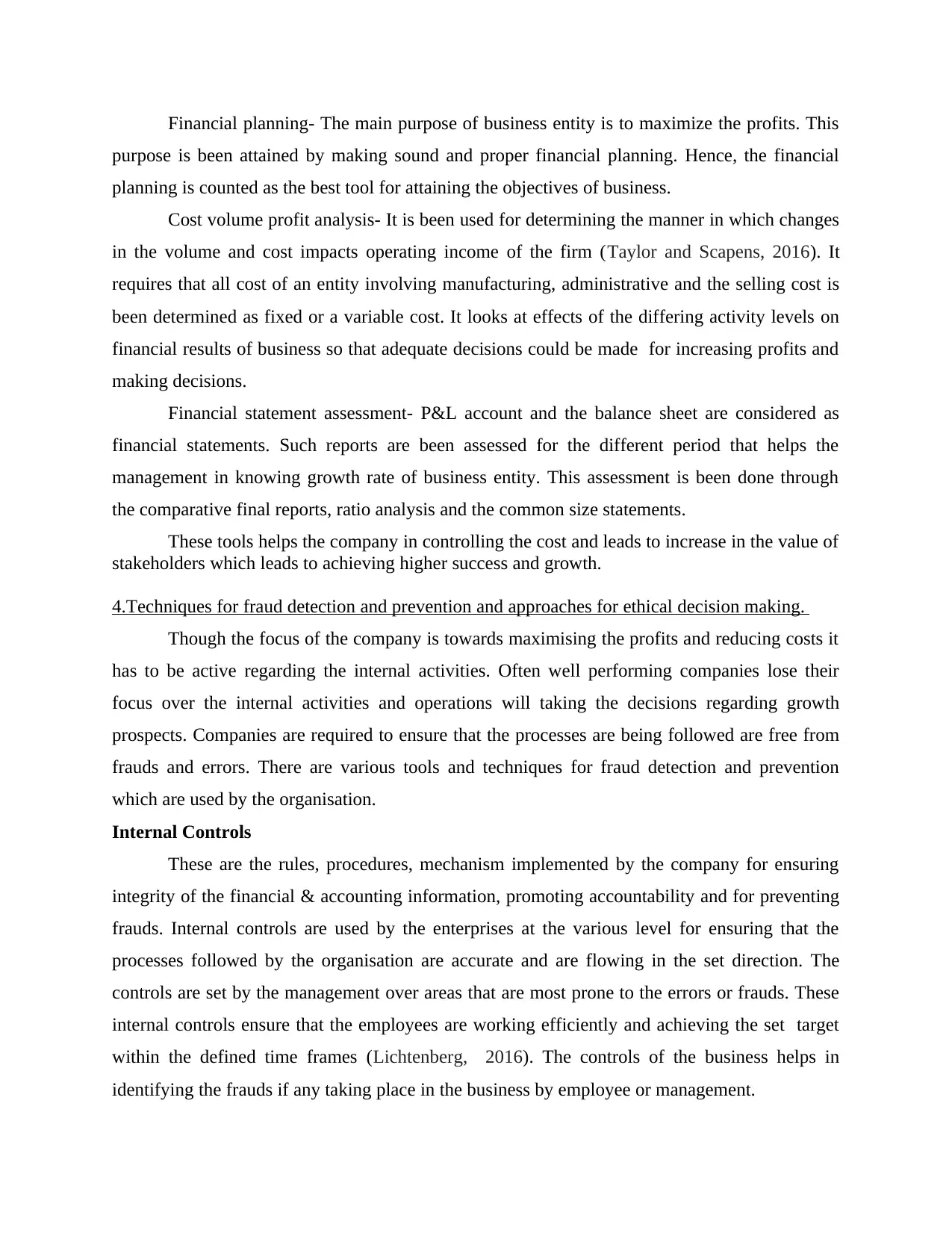
Financial planning- The main purpose of business entity is to maximize the profits. This
purpose is been attained by making sound and proper financial planning. Hence, the financial
planning is counted as the best tool for attaining the objectives of business.
Cost volume profit analysis- It is been used for determining the manner in which changes
in the volume and cost impacts operating income of the firm (Taylor and Scapens, 2016). It
requires that all cost of an entity involving manufacturing, administrative and the selling cost is
been determined as fixed or a variable cost. It looks at effects of the differing activity levels on
financial results of business so that adequate decisions could be made for increasing profits and
making decisions.
Financial statement assessment- P&L account and the balance sheet are considered as
financial statements. Such reports are been assessed for the different period that helps the
management in knowing growth rate of business entity. This assessment is been done through
the comparative final reports, ratio analysis and the common size statements.
These tools helps the company in controlling the cost and leads to increase in the value of
stakeholders which leads to achieving higher success and growth.
4.Techniques for fraud detection and prevention and approaches for ethical decision making.
Though the focus of the company is towards maximising the profits and reducing costs it
has to be active regarding the internal activities. Often well performing companies lose their
focus over the internal activities and operations will taking the decisions regarding growth
prospects. Companies are required to ensure that the processes are being followed are free from
frauds and errors. There are various tools and techniques for fraud detection and prevention
which are used by the organisation.
Internal Controls
These are the rules, procedures, mechanism implemented by the company for ensuring
integrity of the financial & accounting information, promoting accountability and for preventing
frauds. Internal controls are used by the enterprises at the various level for ensuring that the
processes followed by the organisation are accurate and are flowing in the set direction. The
controls are set by the management over areas that are most prone to the errors or frauds. These
internal controls ensure that the employees are working efficiently and achieving the set target
within the defined time frames (Lichtenberg, 2016). The controls of the business helps in
identifying the frauds if any taking place in the business by employee or management.
purpose is been attained by making sound and proper financial planning. Hence, the financial
planning is counted as the best tool for attaining the objectives of business.
Cost volume profit analysis- It is been used for determining the manner in which changes
in the volume and cost impacts operating income of the firm (Taylor and Scapens, 2016). It
requires that all cost of an entity involving manufacturing, administrative and the selling cost is
been determined as fixed or a variable cost. It looks at effects of the differing activity levels on
financial results of business so that adequate decisions could be made for increasing profits and
making decisions.
Financial statement assessment- P&L account and the balance sheet are considered as
financial statements. Such reports are been assessed for the different period that helps the
management in knowing growth rate of business entity. This assessment is been done through
the comparative final reports, ratio analysis and the common size statements.
These tools helps the company in controlling the cost and leads to increase in the value of
stakeholders which leads to achieving higher success and growth.
4.Techniques for fraud detection and prevention and approaches for ethical decision making.
Though the focus of the company is towards maximising the profits and reducing costs it
has to be active regarding the internal activities. Often well performing companies lose their
focus over the internal activities and operations will taking the decisions regarding growth
prospects. Companies are required to ensure that the processes are being followed are free from
frauds and errors. There are various tools and techniques for fraud detection and prevention
which are used by the organisation.
Internal Controls
These are the rules, procedures, mechanism implemented by the company for ensuring
integrity of the financial & accounting information, promoting accountability and for preventing
frauds. Internal controls are used by the enterprises at the various level for ensuring that the
processes followed by the organisation are accurate and are flowing in the set direction. The
controls are set by the management over areas that are most prone to the errors or frauds. These
internal controls ensure that the employees are working efficiently and achieving the set target
within the defined time frames (Lichtenberg, 2016). The controls of the business helps in
identifying the frauds if any taking place in the business by employee or management.
Paraphrase This Document
Need a fresh take? Get an instant paraphrase of this document with our AI Paraphraser
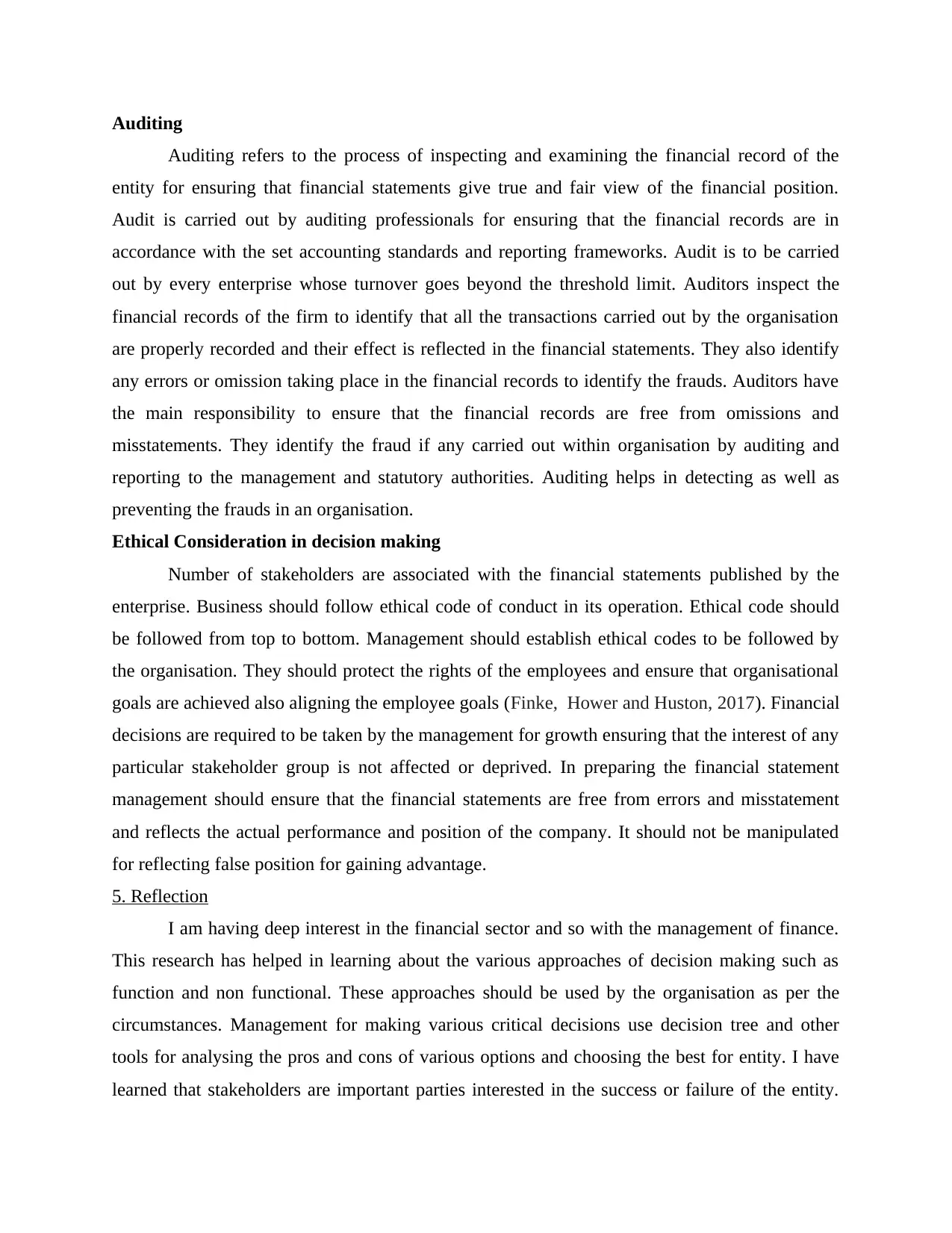
Auditing
Auditing refers to the process of inspecting and examining the financial record of the
entity for ensuring that financial statements give true and fair view of the financial position.
Audit is carried out by auditing professionals for ensuring that the financial records are in
accordance with the set accounting standards and reporting frameworks. Audit is to be carried
out by every enterprise whose turnover goes beyond the threshold limit. Auditors inspect the
financial records of the firm to identify that all the transactions carried out by the organisation
are properly recorded and their effect is reflected in the financial statements. They also identify
any errors or omission taking place in the financial records to identify the frauds. Auditors have
the main responsibility to ensure that the financial records are free from omissions and
misstatements. They identify the fraud if any carried out within organisation by auditing and
reporting to the management and statutory authorities. Auditing helps in detecting as well as
preventing the frauds in an organisation.
Ethical Consideration in decision making
Number of stakeholders are associated with the financial statements published by the
enterprise. Business should follow ethical code of conduct in its operation. Ethical code should
be followed from top to bottom. Management should establish ethical codes to be followed by
the organisation. They should protect the rights of the employees and ensure that organisational
goals are achieved also aligning the employee goals (Finke, Hower and Huston, 2017). Financial
decisions are required to be taken by the management for growth ensuring that the interest of any
particular stakeholder group is not affected or deprived. In preparing the financial statement
management should ensure that the financial statements are free from errors and misstatement
and reflects the actual performance and position of the company. It should not be manipulated
for reflecting false position for gaining advantage.
5. Reflection
I am having deep interest in the financial sector and so with the management of finance.
This research has helped in learning about the various approaches of decision making such as
function and non functional. These approaches should be used by the organisation as per the
circumstances. Management for making various critical decisions use decision tree and other
tools for analysing the pros and cons of various options and choosing the best for entity. I have
learned that stakeholders are important parties interested in the success or failure of the entity.
Auditing refers to the process of inspecting and examining the financial record of the
entity for ensuring that financial statements give true and fair view of the financial position.
Audit is carried out by auditing professionals for ensuring that the financial records are in
accordance with the set accounting standards and reporting frameworks. Audit is to be carried
out by every enterprise whose turnover goes beyond the threshold limit. Auditors inspect the
financial records of the firm to identify that all the transactions carried out by the organisation
are properly recorded and their effect is reflected in the financial statements. They also identify
any errors or omission taking place in the financial records to identify the frauds. Auditors have
the main responsibility to ensure that the financial records are free from omissions and
misstatements. They identify the fraud if any carried out within organisation by auditing and
reporting to the management and statutory authorities. Auditing helps in detecting as well as
preventing the frauds in an organisation.
Ethical Consideration in decision making
Number of stakeholders are associated with the financial statements published by the
enterprise. Business should follow ethical code of conduct in its operation. Ethical code should
be followed from top to bottom. Management should establish ethical codes to be followed by
the organisation. They should protect the rights of the employees and ensure that organisational
goals are achieved also aligning the employee goals (Finke, Hower and Huston, 2017). Financial
decisions are required to be taken by the management for growth ensuring that the interest of any
particular stakeholder group is not affected or deprived. In preparing the financial statement
management should ensure that the financial statements are free from errors and misstatement
and reflects the actual performance and position of the company. It should not be manipulated
for reflecting false position for gaining advantage.
5. Reflection
I am having deep interest in the financial sector and so with the management of finance.
This research has helped in learning about the various approaches of decision making such as
function and non functional. These approaches should be used by the organisation as per the
circumstances. Management for making various critical decisions use decision tree and other
tools for analysing the pros and cons of various options and choosing the best for entity. I have
learned that stakeholders are important parties interested in the success or failure of the entity.
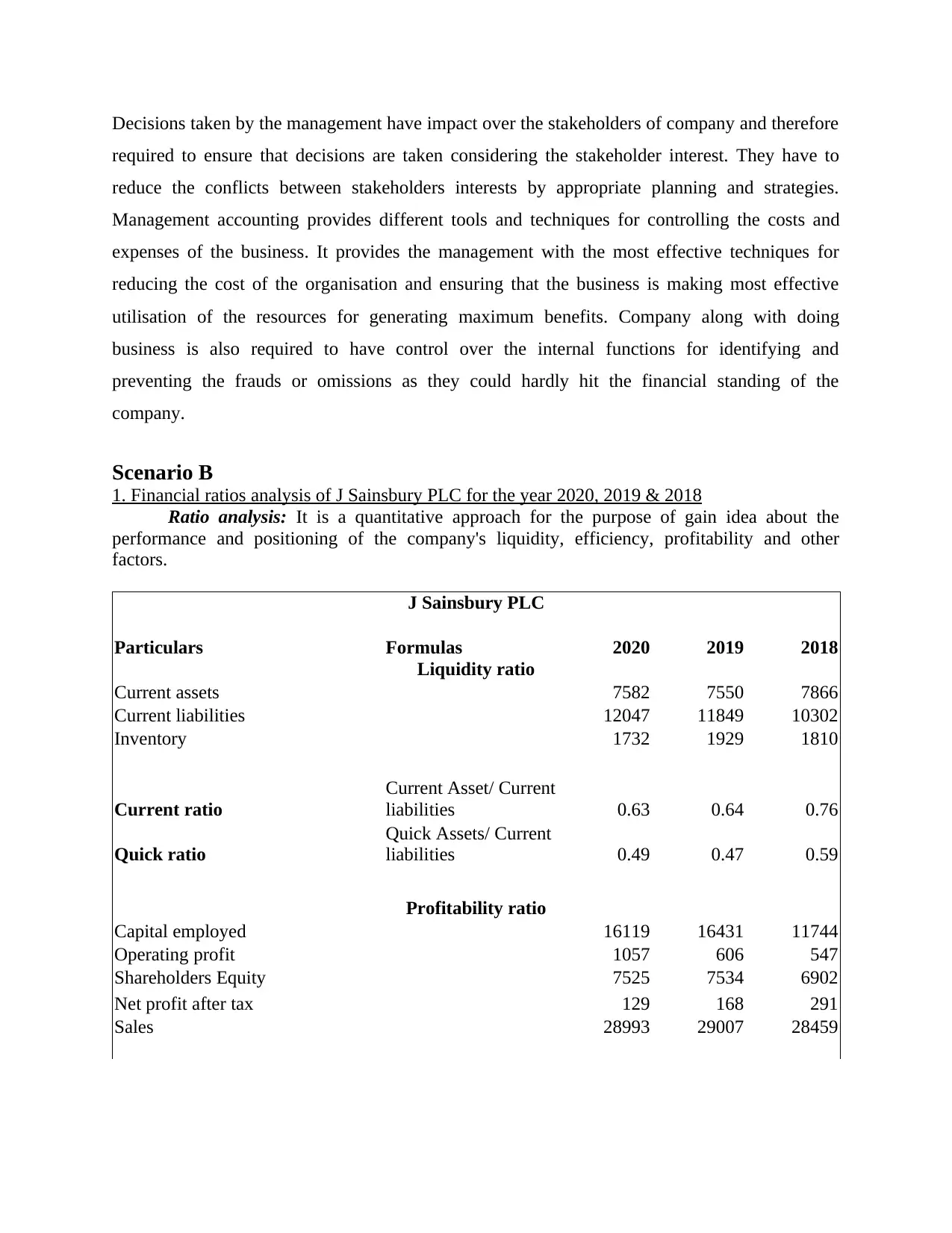
Decisions taken by the management have impact over the stakeholders of company and therefore
required to ensure that decisions are taken considering the stakeholder interest. They have to
reduce the conflicts between stakeholders interests by appropriate planning and strategies.
Management accounting provides different tools and techniques for controlling the costs and
expenses of the business. It provides the management with the most effective techniques for
reducing the cost of the organisation and ensuring that the business is making most effective
utilisation of the resources for generating maximum benefits. Company along with doing
business is also required to have control over the internal functions for identifying and
preventing the frauds or omissions as they could hardly hit the financial standing of the
company.
Scenario B
1. Financial ratios analysis of J Sainsbury PLC for the year 2020, 2019 & 2018
Ratio analysis: It is a quantitative approach for the purpose of gain idea about the
performance and positioning of the company's liquidity, efficiency, profitability and other
factors.
J Sainsbury PLC
Particulars Formulas 2020 2019 2018
Liquidity ratio
Current assets 7582 7550 7866
Current liabilities 12047 11849 10302
Inventory 1732 1929 1810
Current ratio
Current Asset/ Current
liabilities 0.63 0.64 0.76
Quick ratio
Quick Assets/ Current
liabilities 0.49 0.47 0.59
Profitability ratio
Capital employed 16119 16431 11744
Operating profit 1057 606 547
Shareholders Equity 7525 7534 6902
Net profit after tax 129 168 291
Sales 28993 29007 28459
required to ensure that decisions are taken considering the stakeholder interest. They have to
reduce the conflicts between stakeholders interests by appropriate planning and strategies.
Management accounting provides different tools and techniques for controlling the costs and
expenses of the business. It provides the management with the most effective techniques for
reducing the cost of the organisation and ensuring that the business is making most effective
utilisation of the resources for generating maximum benefits. Company along with doing
business is also required to have control over the internal functions for identifying and
preventing the frauds or omissions as they could hardly hit the financial standing of the
company.
Scenario B
1. Financial ratios analysis of J Sainsbury PLC for the year 2020, 2019 & 2018
Ratio analysis: It is a quantitative approach for the purpose of gain idea about the
performance and positioning of the company's liquidity, efficiency, profitability and other
factors.
J Sainsbury PLC
Particulars Formulas 2020 2019 2018
Liquidity ratio
Current assets 7582 7550 7866
Current liabilities 12047 11849 10302
Inventory 1732 1929 1810
Current ratio
Current Asset/ Current
liabilities 0.63 0.64 0.76
Quick ratio
Quick Assets/ Current
liabilities 0.49 0.47 0.59
Profitability ratio
Capital employed 16119 16431 11744
Operating profit 1057 606 547
Shareholders Equity 7525 7534 6902
Net profit after tax 129 168 291
Sales 28993 29007 28459
⊘ This is a preview!⊘
Do you want full access?
Subscribe today to unlock all pages.

Trusted by 1+ million students worldwide
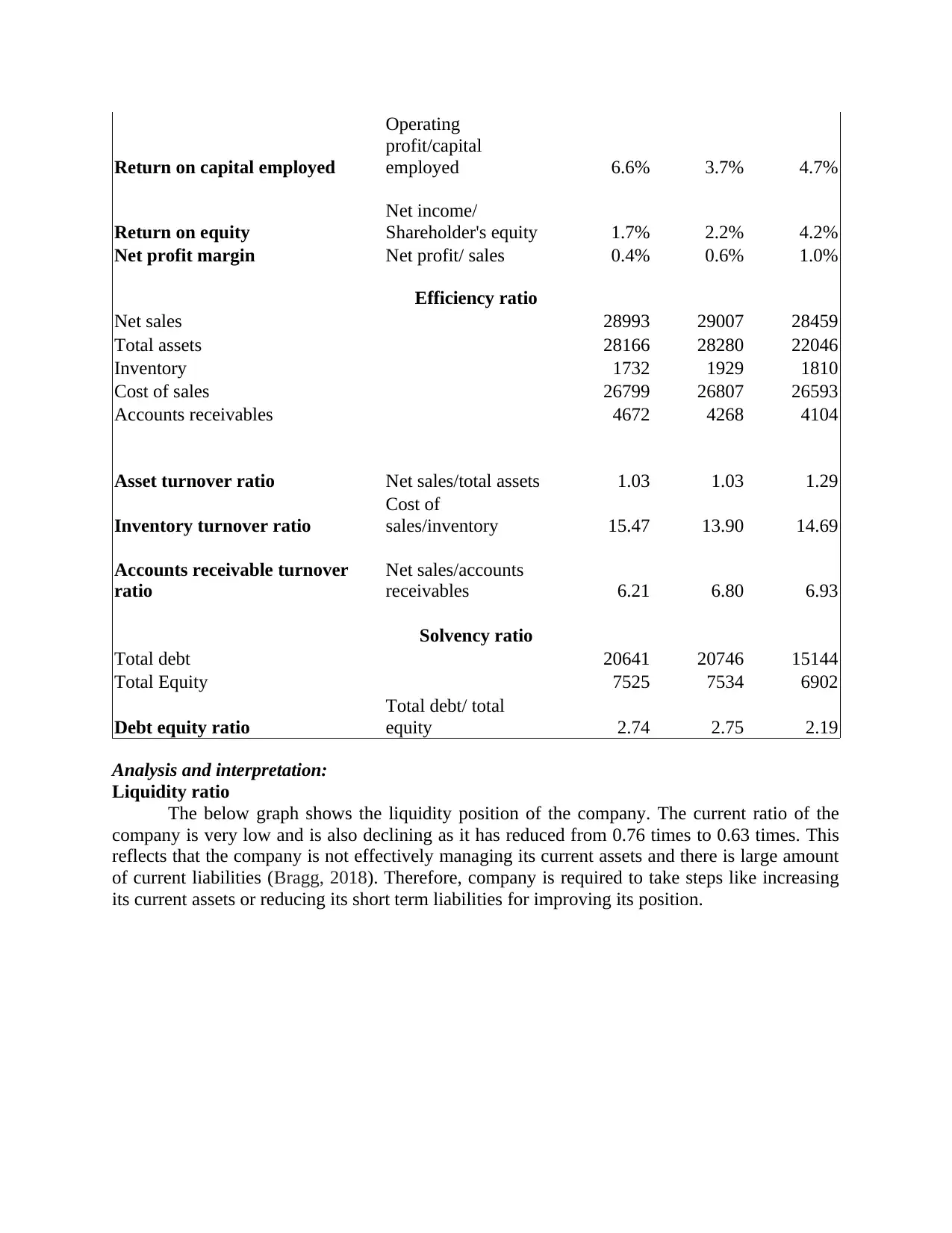
Return on capital employed
Operating
profit/capital
employed 6.6% 3.7% 4.7%
Return on equity
Net income/
Shareholder's equity 1.7% 2.2% 4.2%
Net profit margin Net profit/ sales 0.4% 0.6% 1.0%
Efficiency ratio
Net sales 28993 29007 28459
Total assets 28166 28280 22046
Inventory 1732 1929 1810
Cost of sales 26799 26807 26593
Accounts receivables 4672 4268 4104
Asset turnover ratio Net sales/total assets 1.03 1.03 1.29
Inventory turnover ratio
Cost of
sales/inventory 15.47 13.90 14.69
Accounts receivable turnover
ratio
Net sales/accounts
receivables 6.21 6.80 6.93
Solvency ratio
Total debt 20641 20746 15144
Total Equity 7525 7534 6902
Debt equity ratio
Total debt/ total
equity 2.74 2.75 2.19
Analysis and interpretation:
Liquidity ratio
The below graph shows the liquidity position of the company. The current ratio of the
company is very low and is also declining as it has reduced from 0.76 times to 0.63 times. This
reflects that the company is not effectively managing its current assets and there is large amount
of current liabilities (Bragg, 2018). Therefore, company is required to take steps like increasing
its current assets or reducing its short term liabilities for improving its position.
Operating
profit/capital
employed 6.6% 3.7% 4.7%
Return on equity
Net income/
Shareholder's equity 1.7% 2.2% 4.2%
Net profit margin Net profit/ sales 0.4% 0.6% 1.0%
Efficiency ratio
Net sales 28993 29007 28459
Total assets 28166 28280 22046
Inventory 1732 1929 1810
Cost of sales 26799 26807 26593
Accounts receivables 4672 4268 4104
Asset turnover ratio Net sales/total assets 1.03 1.03 1.29
Inventory turnover ratio
Cost of
sales/inventory 15.47 13.90 14.69
Accounts receivable turnover
ratio
Net sales/accounts
receivables 6.21 6.80 6.93
Solvency ratio
Total debt 20641 20746 15144
Total Equity 7525 7534 6902
Debt equity ratio
Total debt/ total
equity 2.74 2.75 2.19
Analysis and interpretation:
Liquidity ratio
The below graph shows the liquidity position of the company. The current ratio of the
company is very low and is also declining as it has reduced from 0.76 times to 0.63 times. This
reflects that the company is not effectively managing its current assets and there is large amount
of current liabilities (Bragg, 2018). Therefore, company is required to take steps like increasing
its current assets or reducing its short term liabilities for improving its position.
Paraphrase This Document
Need a fresh take? Get an instant paraphrase of this document with our AI Paraphraser
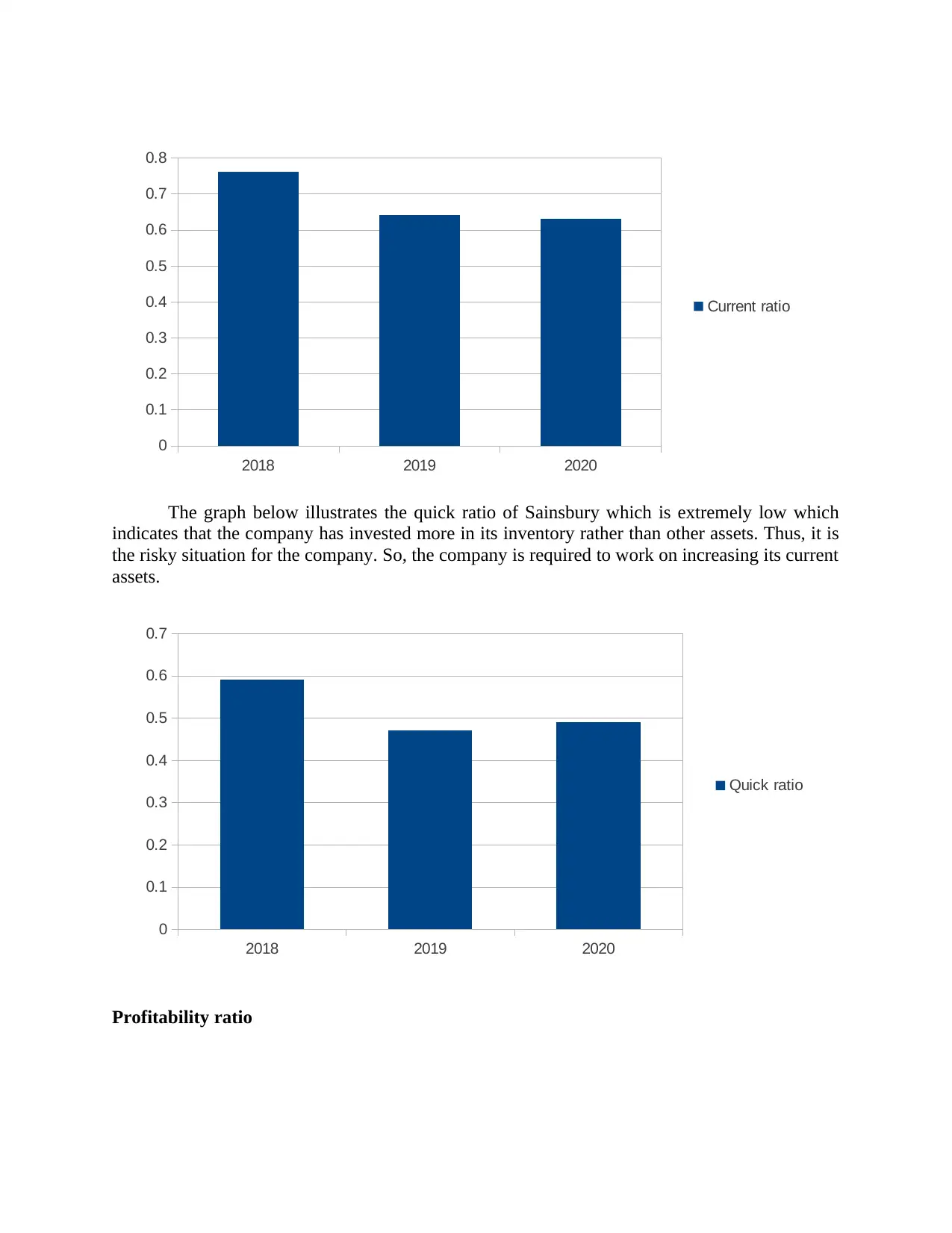
2018 2019 2020
0
0.1
0.2
0.3
0.4
0.5
0.6
0.7
0.8
Current ratio
The graph below illustrates the quick ratio of Sainsbury which is extremely low which
indicates that the company has invested more in its inventory rather than other assets. Thus, it is
the risky situation for the company. So, the company is required to work on increasing its current
assets.
2018 2019 2020
0
0.1
0.2
0.3
0.4
0.5
0.6
0.7
Quick ratio
Profitability ratio
0
0.1
0.2
0.3
0.4
0.5
0.6
0.7
0.8
Current ratio
The graph below illustrates the quick ratio of Sainsbury which is extremely low which
indicates that the company has invested more in its inventory rather than other assets. Thus, it is
the risky situation for the company. So, the company is required to work on increasing its current
assets.
2018 2019 2020
0
0.1
0.2
0.3
0.4
0.5
0.6
0.7
Quick ratio
Profitability ratio
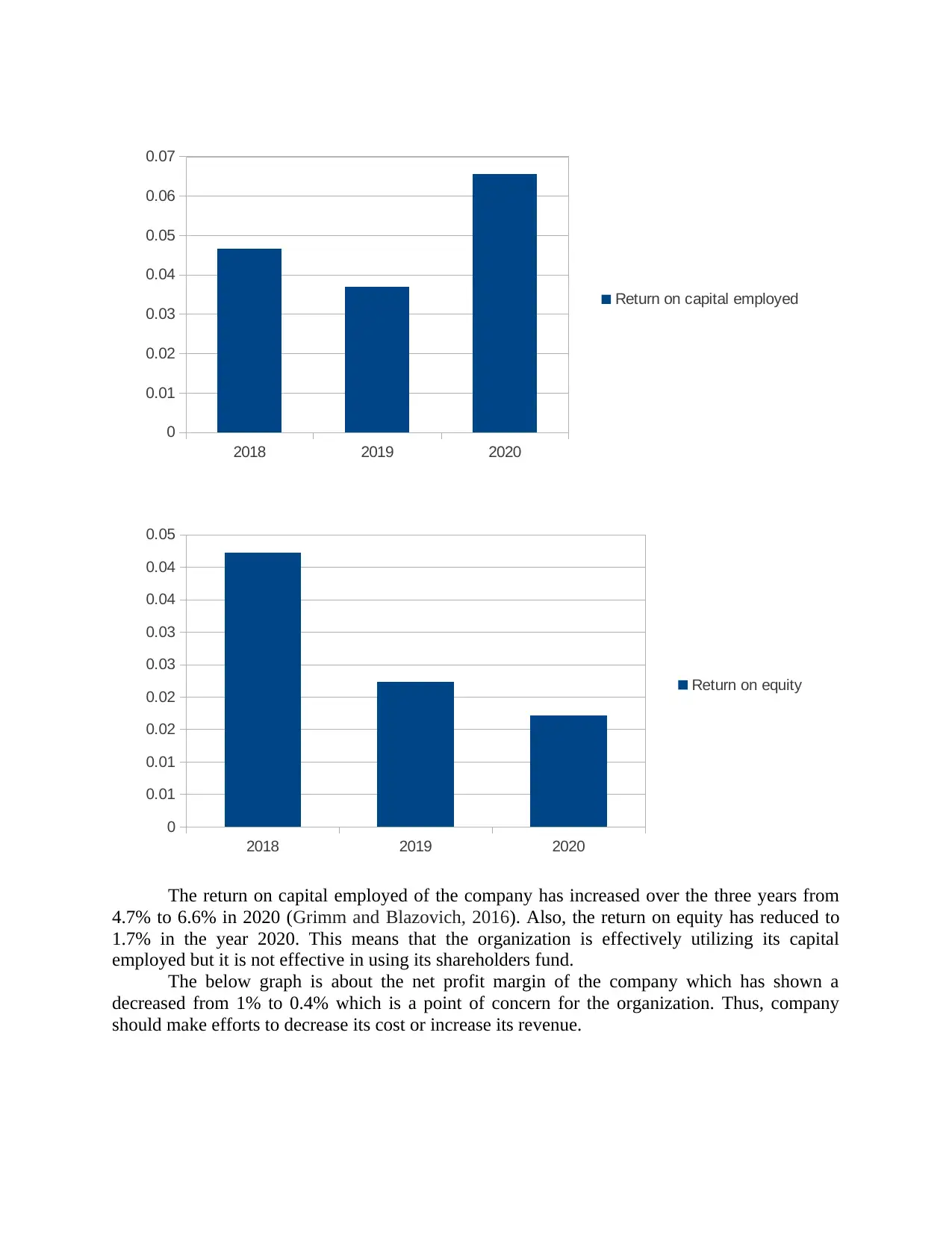
2018 2019 2020
0
0.01
0.02
0.03
0.04
0.05
0.06
0.07
Return on capital employed
2018 2019 2020
0
0.01
0.01
0.02
0.02
0.03
0.03
0.04
0.04
0.05
Return on equity
The return on capital employed of the company has increased over the three years from
4.7% to 6.6% in 2020 (Grimm and Blazovich, 2016). Also, the return on equity has reduced to
1.7% in the year 2020. This means that the organization is effectively utilizing its capital
employed but it is not effective in using its shareholders fund.
The below graph is about the net profit margin of the company which has shown a
decreased from 1% to 0.4% which is a point of concern for the organization. Thus, company
should make efforts to decrease its cost or increase its revenue.
0
0.01
0.02
0.03
0.04
0.05
0.06
0.07
Return on capital employed
2018 2019 2020
0
0.01
0.01
0.02
0.02
0.03
0.03
0.04
0.04
0.05
Return on equity
The return on capital employed of the company has increased over the three years from
4.7% to 6.6% in 2020 (Grimm and Blazovich, 2016). Also, the return on equity has reduced to
1.7% in the year 2020. This means that the organization is effectively utilizing its capital
employed but it is not effective in using its shareholders fund.
The below graph is about the net profit margin of the company which has shown a
decreased from 1% to 0.4% which is a point of concern for the organization. Thus, company
should make efforts to decrease its cost or increase its revenue.
⊘ This is a preview!⊘
Do you want full access?
Subscribe today to unlock all pages.

Trusted by 1+ million students worldwide
1 out of 21
Related Documents
Your All-in-One AI-Powered Toolkit for Academic Success.
+13062052269
info@desklib.com
Available 24*7 on WhatsApp / Email
![[object Object]](/_next/static/media/star-bottom.7253800d.svg)
Unlock your academic potential
Copyright © 2020–2025 A2Z Services. All Rights Reserved. Developed and managed by ZUCOL.





